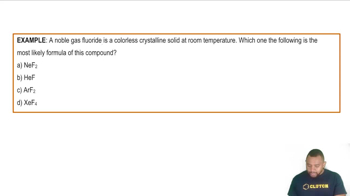Here are the essential concepts you must grasp in order to answer the question correctly.
Ionization Energy
Ionization energy is the amount of energy required to remove an electron from an atom in its gaseous state. It is a key property that reflects how strongly an atom holds onto its electrons. Generally, ionization energy increases across a period from left to right due to increasing nuclear charge and decreases down a group as the distance between the nucleus and the outermost electrons increases.
Recommended video:
Periodic Trends
Periodic trends refer to the predictable patterns observed in the properties of elements as you move across or down the periodic table. For ionization energy, the trend shows that elements on the right side of the table (like noble gases) tend to have higher ionization energies, while those on the left (like alkali metals) have lower ionization energies. Understanding these trends helps in predicting the behavior of elements.
Recommended video:
Noble Gases and Alkali Metals
Noble gases, located in Group 18 of the periodic table, have the highest ionization energies due to their full valence electron shells, making them stable and less likely to lose electrons. In contrast, alkali metals, found in Group 1, have the lowest ionization energies because they have a single electron in their outer shell, which is easily removed. This distinction is crucial for identifying the elements with the smallest and largest ionization energies.
Recommended video:
Noble Gas Compounds Example
 McMurry 8th Edition
McMurry 8th Edition Ch.6 - Ionic Compounds: Periodic Trends and Bonding Theory
Ch.6 - Ionic Compounds: Periodic Trends and Bonding Theory Problem 57
Problem 57 Verified step by step guidance
Verified step by step guidance

